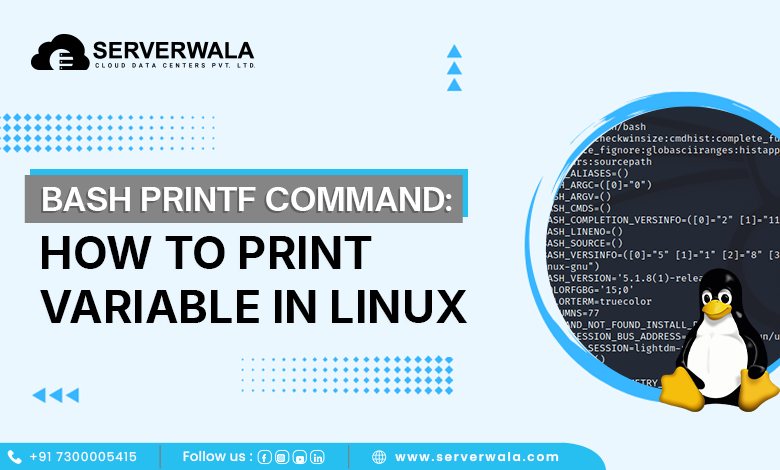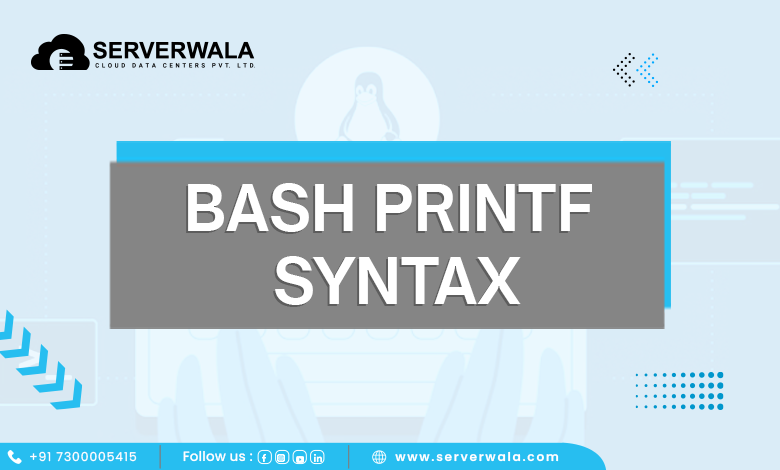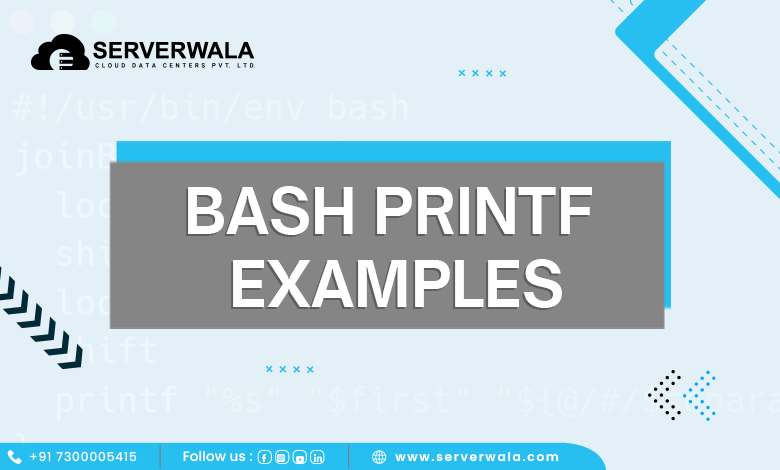Bash Printf Command: How To Print Variable In Linux

Introduction
When working with Bash scripts, efficiently displaying information is crucial. The bash printf command provides a powerful way to format and print text and variables in Linux. Unlike echo, which is simpler, **printf in bash** gives more control over how data is displayed. Whether you need to align text, format numbers, or display bash print variables with precision, printf bash is your go-to tool. In this guide, we’ll explore bash printf syntax and how to use format specifiers to customize your output.
Bash printf Syntax

The bash printf syntax closely resembles that of C language. It starts with printf, followed by a bash format string and variables or values you want to print. Here’s the general structure:
printf "format-string" [arguments...]The format string implies how the output will seem, with placeholders like %s for strings and %d for integers. The arguments correspond to these placeholders, allowing you to print variables or text in a structured manner. Unlike echo, bash printf doesn’t automatically add a newline at the end, so you may need to include \n in the format string for line breaks.
Example:
name=”Alice”
printf “Hello, %s!\n” “$name”
In this example, the printf bash command prints the text “Hello, Alice!” by inserting the value of the name variable.
printf Specifiers
In bash printf, specifiers control how values are formatted and displayed. They act as placeholders in the bash format string, allowing you to customize how text, numbers, and other data types are printed. Below are the most common printf specifiers you can use for printing in bash.
- %s: Prints a string. It replaces the placeholder with a string value or a bash print variable.
- %d: Prints an integer. Ideal for print bash operations involving whole numbers.
- %f: Prints a floating-point number. You can mention precision using formats like %.2f to print two decimal places.
- %x: Prints an integer in hexadecimal format (lowercase).
- %X: Similar to %x, but prints the hexadecimal in uppercase.
- %o: Prints an integer in octal format.
- %e: Prints a floating-point number in scientific notation (lowercase).
- %E: Similar to %e, but uses uppercase for scientific notation.
- %c: Prints a single character. This can be useful for shell print scripts that deal with character manipulation.
- %u: Prints an unsigned integer.
- %%: Prints a literal % symbol.
Available Format Modifiers
In addition to specifiers, bash printf supports format modifiers to further control the output. Here are the common modifiers you can use when printing in bash:
- Width: Sets the minimum field width. For example, %5s reserves five characters for a string, adding spaces if necessary.
- Precision: For floating-point numbers, you can define how many digits gets shown after the decimal. For example, %.2f prints a float with two decimal places.
- Left-justify (–): Aligns the value to the left within the field width. For example, %-10s left-justifies a string in a 10-character field.
- Zero-padding (0): Pads the number with zeros instead of spaces. For instance, %05d will print a 5-digit integer, padded with zeros if necessary.
These modifiers give you greater control over bash print variable output, ensuring numbers and strings are displayed as needed in your shell print tasks.
Example:
number=42
printf “Number: %05d\n” “$number”
This printf bash command prints the number 42 padded with zeros, making it a 5-digit output (00042).
Understanding these bash printf examples and using format modifiers allow you to create highly customized outputs in your bash script print operations, making your scripts more precise and readable.
Also Read: How To Use The Echo Command In Linux?
Bash printf Examples

Here are some common bash printf examples that show how to use the bash printf command to print variables and format output in various ways.
Separate Output with a Newline Character
By default, printf in bash does not automatically add a newline. To print each output on a new line, include \n in the bash format string.
printf "Hello, World!\n"
printf "Bash printf adds more control\n"Unlike bash println, which doesn’t exist in Bash by default, this will print each message on a separate line.
Print Multiple Variables
You can print multiple variables in bash using a single printf bash command. Each placeholder in the bash format string corresponds to a variable.
name="Alice"
age=30
printf "Name: %s, Age: %d\n" "$name" "$age"Here, the %s and %d specifiers handle the string and integer values, respectively, making it easier to print bash variables in structured formats.
Print Variable in a Mock Table
You can align and print variables in a tabular format using bash printf. Adjust field widths to create columns.
printf “%-10s %-10s\n” “Name” “Age”
printf “%-10s %-10d\n” “Alice” 30
printf “%-10s %-10d\n” “Bob” 25
This shell printf example prints names and ages neatly aligned in a table-like structure. Useful in bash script print tasks for better readability.
Add Decimal Points
To print a variable in bash with decimal precision, use the %.nf format, where n is the no. of decimal places.
pi=3.14159
printf “Pi rounded to two decimals: %.2f\n” “$pi”
This bash print variable example rounds the value of pi to two decimal places.
Store Data in a Variable
You can also store printf in bash output in a variable for later use.
output=$(printf “User: %s, ID: %d\n” “Alice” 101)
echo “$output”
This technique allows you to use print bash output later in your script.
Convert Hexadecimal Numbers
Convert hexadecimal to decimal in Bash using %d to interpret the number as an integer.
hex="0xFF"
printf "Hexadecimal %s in decimal is %d\n" "$hex" "$hex"This converts 0xFF to its decimal value, 255, providing an easy way to convert numbers in bash.
Convert Decimal Numbers to Octal
To print a decimal number as octal, use the %o specifier.
decimal=15
printf "Decimal %d in octal is %o\n" "$decimal" "$decimal"This prints the number 15 as 17 in octal format, useful for tasks requiring print in shell script involving number systems.
Print Date
You can print the current date using Bash’s built-in date command with printf bash.
current_date=$(date +"%Y-%m-%d")
printf "Today's date: %s\n" "$current_date"This displays the date in the YYYY-MM-DD format.
Add Commas to Thousands
You can add commas to large numbers using printf in bash for better readability.
number=1234567
printf "%'d\n" "$number"This will print 1,234,567, useful for making large numbers easier to read in bash script print output.
Get Character ASCII Code
Print ASCII codes for characters using %d with bash printf.
char="A"
printf "ASCII code for %s is %d\n" "$char" "'$char"This prints the ASCII value of the character A, which is 65, useful for character handling in bash script tasks.
Also Read: How to Use the Linux Diff Command?
Conclusion
The bash printf command is an essential tool for formatting and displaying output in Linux. Unlike the basic echo, printf in bash gives you more control over how data is printed, making it a powerful choice for structured output. You can easily use bash printf to format strings, integers, floating-point numbers, and more, giving your scripts a professional touch.
With specifiers and modifiers, printf bash allows you to customize outputs, whether you’re printing multiple variables, converting numbers, or formatting dates. From adding decimal points to creating tables, these features offer precision when working with data in a bash script print scenario.
By mastering bash printf examples, you can streamline your shell print processes, making it easier to handle complex output in a bash format string. Whether you’re working with variables, dates, or hexadecimal numbers, the ability to control formatting ensures that your bash print variable tasks are handled effectively.
Understanding how to print in bash with printf improves your script’s readability and accuracy. It enhances output flexibility in print in shell script operations, proving essential in any bash script. So, the next time you’re dealing with text or data in your script, consider using bash printf for better results.





